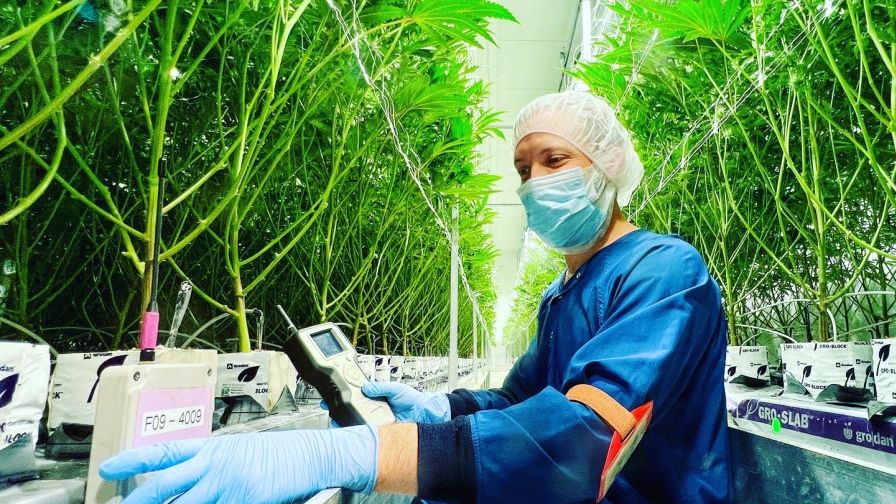How Growers Benefit From a Cannabis-Specific Approach to Crop Steering

Msiku cannabis brand; Photo: AtlantiCann Medical Inc.
Crop steering isn’t a new concept — for as long as humans have engaged in agriculture, they have been fine-tuning methods for getting better yields. In the field, in a greenhouse, or indoors, it’s a matter of managing the strategic application of water and fertilizer, in line with the climate, throughout the phases of plant development.
That said, technology and methodologies available for crop steering have vastly improved over time, especially for plants like cannabis that were long left out of research and development efforts afforded to other crops. It is a critical time to expand knowledge about commercial cannabis production techniques and empower commercial growers to optimize their facility efficiency and use of resources.
I spent more than two decades in the horticulture sector working with hydroponic vegetable growers before becoming involved with commercial cannabis in North America, and observed firsthand how similar the production concerns are between food crops and cannabis. With tomatoes and cucumbers, for example, maximizing yield and quality are crucial, and production concerns are amplified when the returns for the product are low. Greenhouse efficiency and growing strategies are everything to these growers.
The operational concerns are similar in cannabis; however, the truth is that these crops have different needs when it comes to resource inputs and the timing of them to achieve the varying commercial production objectives.
As cultivators grapple with wholesale volatility in state markets, facility efficiency and responsible resource use in cannabis have never been more important. Proven crop-steering techniques used in hydroponic vegetable production solve some challenges. However, cannabis cultivators need research-based strategies that are designed for the crop they grow and its intended market use.
Closing Knowledge Gaps
Because of long-standing barriers to the study of cannabis, cultivators have had to develop their own knowledge and strategies at their facilities for decades. A few shared their knowledge as states like California and Colorado and countries like Canada legalized cannabis. And in the years since, licensed cultivators and ancillary consultants have shared tips, observations, and best practices with one another on how best to maximize cannabis yields with the technology available.
That approach has not been very scientific or structured, but as the cannabis industry has swelled to an estimated value of more than $28 billion in 2021, there have been more opportunities than ever for scientists and academic researchers to delve deeper. NORML estimates that nearly 4,000 scientific papers were published about cannabis in 2021 alone — a record-breaking number.
While many recent studies are medical in nature — focused on the inner workings of the human endocannabinoid system and the properties of various cannabinoids — not all are. The horticultural side of cannabis has received renewed interest as well, and particularly how cultivators can best grow and steer this crop to its fullest potential.
Cultivators need a dedicated methodology for cannabis crops. As the industry grows, competition among cannabis producers means that supply gluts regularly drive down wholesale prices for farmers to unsustainable lows. Maximizing yields without increasing operational costs is one of the best ways for growers to survive a volatile market.
Creating tailored strategies for the highly varied production goals of cannabis-derived pharmaceuticals, extracts and concentrates, as well as raw flower is crucial, too. Growers of other crops like tomatoes face similar challenges — there are different strategies for growing and processing tomatoes for ketchup versus the tomatoes that end up on top of your chef salad.
For example, cultivators of cannabis for pharmaceuticals might emphasize cleanliness, testing and a lack of contamination, as well as the targeted active pharmaceutical ingredient (API) or cannabinoid. When growing for extracts, cultivators are primarily motivated to maximize potency, flavor and terpene content. When cultivators are growing flower for the consumer market, however, the grower needs to target not only potency, flavor, and terpene content, but also aesthetics.
Crop Steering Cuts Costs
Crop steering benefits more than carefully tended cannabis plants, however. When cultivators are strategic about resource management from seedling or clone to a bud-laden mature plant, they’re also saving money by conserving their input resources. Those savings are multiplied when cultivators implement sustainability-focused technologies that lend themselves to controlled-environment agriculture such as drip irrigation, LED lighting, vertical grow systems, automation technology, and substrates designed for rootzone management. Learn more in Grodan’s Crop Steering Report here.
All those technologies facilitate crop-steering techniques and can help to minimize labor hours by reducing how often employees need to touch each plant throughout the production cycle. While no one practice can truly insulate cannabis producers from market fluctuations, reduced operating costs combined with greater yields can certainly go far to stabilize even newer cannabis cultivation operations, while improving customer satisfaction.
This is an exciting time to be in the cannabis industry. Every year, growers learn more about the unique needs of cannabis cultivars even as technology improves to simplify the cultivation experience. This attention from the scientific and research communities is long overdue, but already it’s unlocking new possibilities for hard-working cultivators.
For more technical advice from the team at Grodan, click here.









